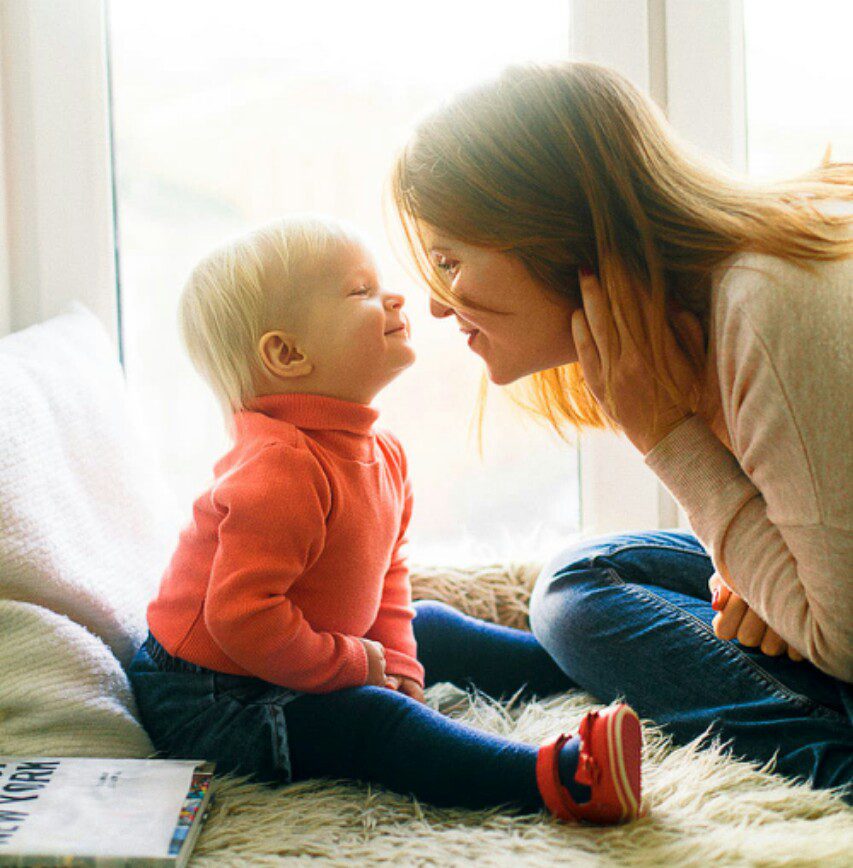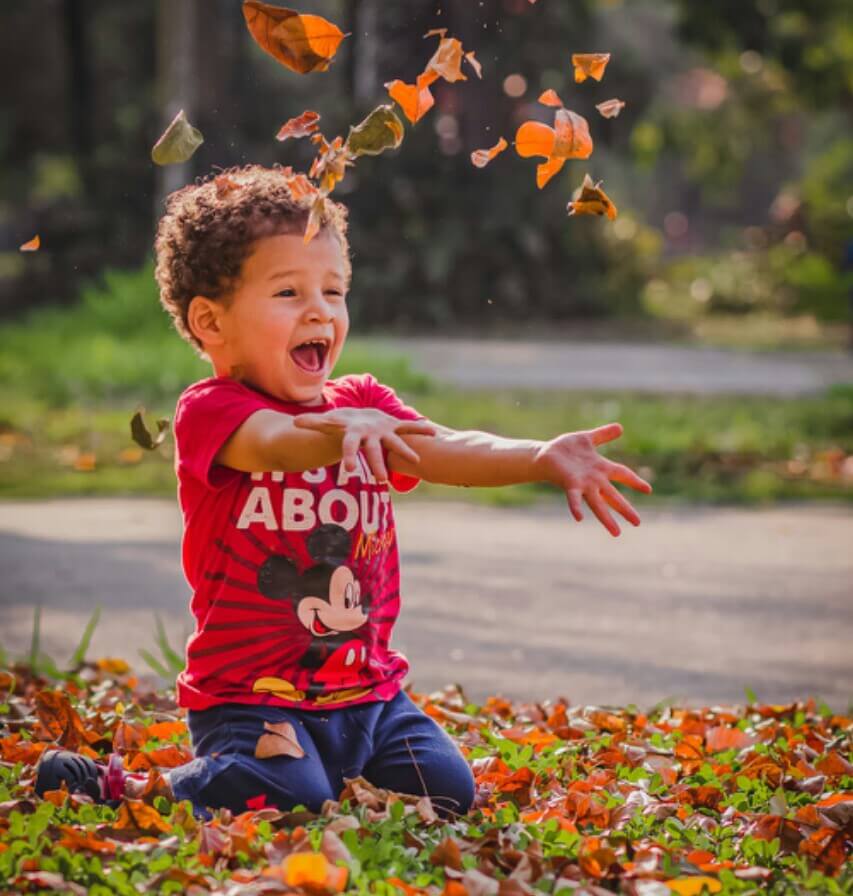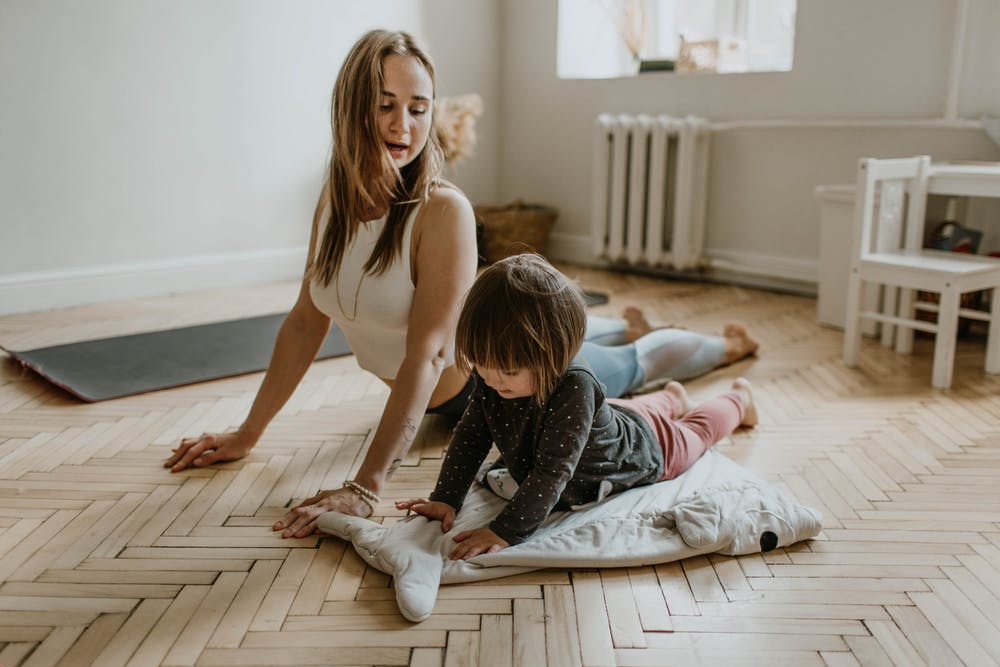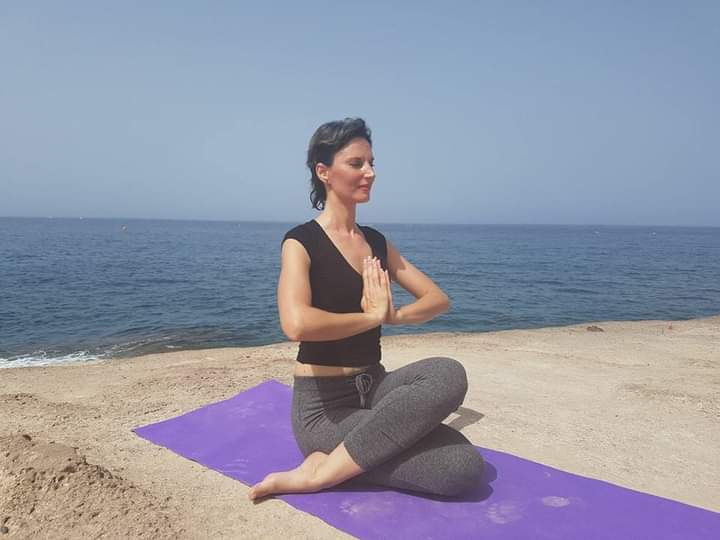The most precious gift we can offer others is our presence. When Mindfulness embraces those we love, they will blow like flowers. – Thich Nhat Hanh

The most effective way to teach your kids about Mindfulness is to be Mindful with them. I named this article “Mindfulness With Kids,” not “For Kids.”
To do so, you need to practice yourself. If you know how to be Mindful as a parent, your kids will learn best from you. You will be able to connect and resonate with them in a much more efficient way, understanding how they react to the experiences they go through.
Your way of resonating with them dramatically influences the development of their brain, and it does so most rapidly during childhood and adolescence. As a parent, you want to shape your children to develop as independent people with empathy, compassion, and self-confidence because you know that life often puts you in brutal confrontations.
To inspire children from an early age to develop awareness about their body, mind, and feelings in the present, Here and Now, without judgment, to deal with problems gently, and to recognize thoughts, emotions, and sensations is your form as a parent, to give them the most valuable gift of love.
Mindfulness is learned through practice, not theory, so if you use mindfulness practice with your kids daily, they will quickly know what it is about and love using it as much as possible. The idea is to be short, funny, and creative!

IS NEVER TOO EARLY!
Parents have often asked me what age children could start with Mindfulness. Mindfulness means paying attention to the present; it is never too early. There are countless specialized programs for pregnant mothers who, after giving birth, are strict about how to create mindful moments with the baby, how to bathe him mindfully, or how to walk and calm him at night if he cries and cannot sleep. But babies grow up and become children, and it is good to keep their interest in Mindfulness before society influences them and changes how they perceive things.
KEEP THEM HAPPY AND PRESENT!
That is why I am coming to your help with some simple activities and tips you can use with your kids to introduce them to Mindfulness.

THE SNOW GLOBE
The best and easiest example to make them understand Mindfulness is the concept of “The snow globe.” When we are upset and cannot think clearly, our agitated mind can be compared to when we shake the globe and can not see the figurines inside. If the kids wait calmly and patiently for the snow to settle down, inhaling slowly and exhaling with you, they will see the figurines inside the globe again.
CONNECTING WITH THE BREATH
As for adults, this technique is the most versatile in being aware of Mindfulness, and it will be the source of understanding how it works for your kids. You can make them pay attention to their breathing by putting a plush doll on their belly and notice how the doll moves slowly, up and down. Another example might be blowing in a balloon or a dandelion.
You can explain to the older children and teenagers to pay attention to the air coming in and out of their nostrils, or they can place one hand on their abdomen and pay attention to how it rises and falls. Please encourage them to observe the changes that occur, the rhythm of breathing, different sensations of the body, and the shift in attention, and to reflect on their experience.
BODY SCAN
The activity you can also use while practicing Mindfulness with kids is to make them lie down on a large sheet of paper, and while drawing their body outline with a pencil, lead their attention to each part next to which you drew the line. Ask them how they felt, if they tickled or had tingling, and the fact that they described the sensation made these sensations aware in their mind without telling you.
It is a beautiful experience, with laughter and giggles, thus leading to relaxation on both sides. If it deviates from the proposed goal, gently return their attention to the body.
You can also do the body scanning before bedtime. Standing in bed with closed eyes, you can gently touch and make them pay attention to every part of their body, starting with the toes and ending with the top of the head. Be creative and induce relaxation with each toe, sole, ankle, etc.
CONNECTING WITH THE SENSES

4.1 Discovering nature
Looking at the beauty in the world is the first step of purifying the mind.
– Arint Ray –
What could be more wonderful than perceiving in the present everything around us, enjoying every sense we have been endowed with, enriching our world, and bringing it colors?
You can draw your kid’s attention to sight (the colors encountered in nature from trees, flowers, sky, sun, clouds, and earth); hearing (the sounds made by the songs of the birds, waves, river, and animals); touch (the sensations when they feel the wind and sun’s rays on their face when they step barefoot on the grass, earth, water, warm sand, or stones); smell (of the rain, the breeze of a sea, the scent of flowers, the fresh smell of cut grass); taste (of fruits and vegetables).
I am sure you understand the idea. It is a stimulating, funny, and, most importantly, mindful activity that improves concentration and focus and nurtures calm, good mood, and happiness.

4.2 Eating Mindful
Another game you can play with kids, and they will love it, is discovering the food’s secrets. You can choose to do it with any food, or easier to start, to use an apple in different colors or any colored fruit, on which, with the help of the senses, its secrets are revealed. Usually, both adults and kids do not pay too much attention to food, or maybe not at all. By proposing to your kids a new way to eat, you will arouse their curiosity, and they will see it as a new adventure.
- they need to describe the colors they see;
- depending on the case, they need to pay attention to its shape, size, and texture;
- to smell and taste it, describing whether it is sweet, bitter, sour, dry, or juicy.
The exercise can take between 2-4 minutes.
WALKING MINDFULNESS
I suggest paying attention to every slow step they take, the way the sole touches the ground, the bending of the knees as they walk, and the balance of the arms.
If they are too small, you can do this walk while you count each step done. The count will keep their attention, and they will know they must take a step when you say a number.

YOGA & MINDFULNESS MEDITATION
6.1 Practicing Yoga with younger toddlers will give them strength, agility, and the ability to adapt; it will make them much calmer and more present. The practice should incorporate animal poses and storytelling to make them stay engaged. Different yoga programs are specially designed for children of all ages to come in for your help.
6.2 Mindfulness Meditation can be done with closed eyes, sitting, or lying on a BUDDHA BEAR’S YOGA MAT. You can use a bell or a singing bowl. The idea is for your kids to sit quietly, relax, and listen for a minute to the sound produced by the instruments.
Disclosure: Some of the links on this website are affiliate links. I may earn a commission if you click through any of them and purchase at no additional cost. I only recommend products or services I trust and believe will add value to my readers. For more information, read the entire affiliate disclosure here.
Meditation and Yoga, practiced from an early age, positively influence the development of children’s brains.
CONNECTING WITH EMOTIONS AND THOUGHTS
Being aware of our thoughts and emotions is a difficult concept, even for us as adults. We will understand their power over us when we learn to be mindful of and observe them.
A simple example of explaining to the kids how the mind works is to make them understand that their thoughts are like wild, restless monkeys that do not sit in one place at all but jump from tree to tree, telling stories that are not valid.
Instead, in terms of emotions, kids experience pleasant or unpleasant sensations, just like you. You can make them understand that their feelings come and go like clouds in a windy sky. They are not there forever. If you connect them to emotions by explaining them as sensations of the body, they will understand them better, both pleasant and unpleasant.
You can give them an example of how they felt when someone behaved nicely or badly with them, especially when they behaved nicely or badly with someone else. This way, they will learn to be aware of their emotions and thoughts in every experience.

DRAWING, PAINTING, AND COLORING BOOKS
Taught your kids to enjoy the pleasure of drawing and coloring because it is an activity through which they can express ideas, thoughts, and feelings, relating according to what they draw and the colors used. My son, for example, was attracted to coloring and drawing only if we did this activity together.
If your kids are the same, enjoy this Mindful moment with them because this activity improves their ability to pay attention, stimulates their creativity, and gives them a state of calm and relaxation.
A beautiful coloring book that encourages kids to be mindful is Buddha Bear, a combination of art and storytelling, following the trip and adventures of the little Buddha Bear, the friends he makes, and the most important values he learns: Compassion, Gratitude, and Discipline. An exciting coloring book that will immediately capture your kids’ attention.
PRACTICE GRATITUDE
Practicing Gratitude is a form of Mindfulness. The fact that you thank the Universe for what you have in your life, in the present, makes you pay special attention to people, moments, and events that are valuable or valuable to you.
Taught your kids what Gratitude means, inspired them to appreciate the people who are part of their life, who love them, and take care of them. Make them understand that they are healthy, have what to eat and what to wear, where to sleep and where to study. I taught them the actual values of Gratitude, to not take anything for granted, and they will know compassion, kindness, and serenity.
Be kind whenever possible. It is always possible!
-Dalai Lama –
TIPS FOR MINDFULNESS PRACTICE
1. Mindfulness is not difficult; you must remember to do it.
2. Always listen Mindful to your kids.
3. Create short practices appropriate to their age to attract their attention and curiosity.
4. Start gradually and patiently to make them open up and show interest.
5. Everything has to be short, funny, and creative.
6. Enjoy the moments with your kiddos simply by being present with and for them. Those moments you will never bring back.
FINAL THOUGHTS
I hope you enjoyed reading this article, and I would love for you to share your mindfulness experience with your kids if you have one or are considering getting more involved in living with them and for them.
Till next time…
Be Mindful And Not Mind Full!
Founder of Dare & Be.
Contact: support&dareandbe.com

We are actually doing things over again. We raised our children years ago and now for the last 8 years we have found ourselves raising our grandson.
The fact of the matter is that raising a child really is different than when I was a child.
I love all the mindful tips you are challenging us with.
It is great that you are willing to take the time and put in the effort on such a great article
Hello Dale,
Thank you for stopping by and reading the article. It is an opportunity to use the Mindfulness activities that I related in the article, with your nephew. This will be an introduction for both of you to the world of Mindfulness.
Hi Diana
You have brought so much usefulness in the quest for mindfulness for both you and your children. The article is crammed with so much information that you wonder if I have been doing it right in the first place. You often try to teach your children on how to be their best, to be considerate, happy and content. This is not an easy route to follow as often you feel that you are doing it wrong and that any technique you use is inadequate. I also believe that to do this you must practice what you preach. Fun activities are great to get children interested but I believe mistakes are a greater teacher.
What would you recommend if both matter what you do your child shows both interest or empath at all?
Thanks
Antonio
Hello Antonio,
Indeed, is like the phrase “you must practice what you preach”. As I said, to know how to get your kids interested about Mindfulness activities, you need first to practice for yourself, and to understand the meaning of being Mindful. In this way, is more easier for you to know how to implement it in your kids life, how to create short, but creative and fun activities to keep them engaged, and how to be patient with them.
Mindfulness with children is a thing everyone who has the privilege to raise a child must practice as a duty. Meaningful engagement with children from the cradle goes a long way to influence their personality, confidence and the way they perceive life. Thank you for explaining the activities that can be employed to achieve mindfulness with our kids. I find the aspect of eating mindful very interesting as it may also help children to appreciate and eat a variety of vegetables and fruits. I will be practising this method with the kids I am mentoring.
Hello Debbie,
What a pleasure to have you here. Thank you for stopping by. Indeed, practicing Mindfulness with children from an early age will shape their personality, self-confidence, and they will learn to focus, pay attention to details and be present in any aspects of their lives.
Try the Mindful eating method with the kids you are monitoring, and let me know how it went.
Hi Diana, What a beautifully written post which I thoroughly enjoyed reading. I love the way in which you use the snowglobe that has been turned upside down, to describe a “fuzzy” mind. And the same with wild monkeys jumping from tree to tree to describe a wandering mind.
I find it so sad that you see so many parents that are on their mobile phones while their kids are trying to get their attention or talking to them, instead of enjoying the moment with them.
Drawing and painting with kids are always so much fun, and to do drawing around their body and asking them what or how they feel, is brilliant. Thanks for reminding me about the importance of mindfulness.
Hi Line,
I am glad you enjoyed reading the article. As I notice, you read it very carefully, and this only can make me happy. Thank you for your appreciation.
As I mentioned in the article, Mindfulness is not difficult at all, we just have to remember to do it, that means to be present in absolutelly any activity. As long as we understand and practice Mindfulness, we will find it much easier to be creative in designing activities for our children.
These are some interesting tips to teach children about mindfulness. Was helping my daughter research ways to teach her three children and her youngest being six months old. Never would have taught about the snow globe effect and how can calm you when it is shaken. The snow globe effect can work with my six-month-old granddaughter and the nature tip for my grandsons. If I may like to share this article with my daughter on social media! This was an awesome read, will bookmark and watch for new articles that you write.
Hello Jannette,
Thanks for taking the time to read the article, and I am glad you found it useful for your grandchildren. In the article are just some of the mindful activities that can be done with children, but of course, they can be modified according to the age and creativity of each parent. Thank you, also for bookmarking and sharing the article in social media. You are more than welcome to return for new updates.
Hi Diana,
These are beautiful practices for mindfulness with children. I liked them all. The snow globe is indeed so calming, also for me. I sometimes shake the two snow globes I have and it always calms my mind. I also loved making yoga more appealing for kids with storytelling and animals. In that way they will surely love yoga. It is also important to help them discover nature and be in tune with it, especially considering the world we live in … I love all these practices you described.
Hi Christine,
I am glad to see you here. Thank you for stopping by, and for your appreciation. As a child, I was attracted to snow globes, and I remember that I liked to shake them, and to watch carefully how the snow calms down, and the details on the figurines as they were made. It is one of the simple but beautiful form of Mindfulness, for both children and adults.